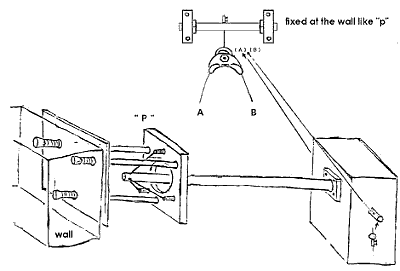4.2 The fixed mounting of the seismograph - pendulums in our station 1/3
We have attached the two stationary horizontal pendulums in our school's cellar to walls as is shown below:
The upper bearing was copied from the front brake of a bicycle; a short wire is fed through the pipe of a bored threaded pin that is held by two small aluminium boards that are in turn fixed to the wall with screws. The metal part of an electrical lamp-insulator holds the wire to the upper side. At the other end of the wire we have fixed a part of a front break of a bicycle. In this is hung the wire-loop, both ends leading to the sides of a block of concrete. The wire is fixed again here with the aid of pipes and clasps.
The lower bearing, that is the bearing of the pin-ended support, is achieved by three wires, which together create a tetrahedron and act as a ball and socket joint.
Our young scientists were particularly proud of this setting: knife-edge bearings and pivots, which are often used in homemade seismographs tend to wear easily over time. In our setting only inner friction of the wire is present.
Altogether we can therefore say: five wires suspend our pendulum, so that only one degree of freedom remains for its movement.
